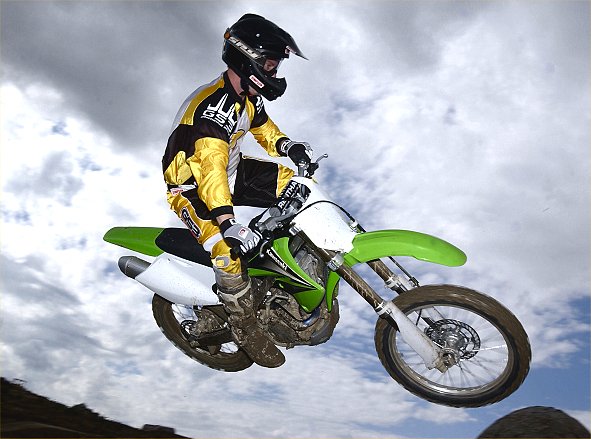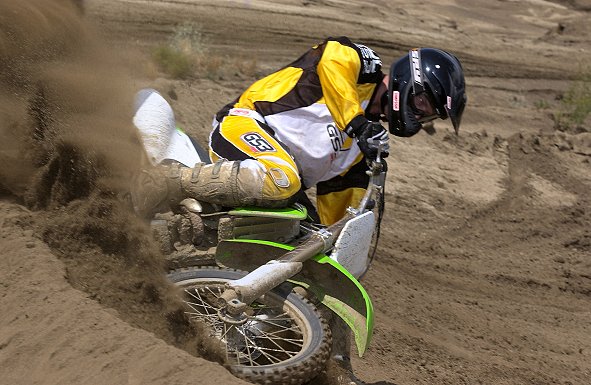
The long wait for a fresh challenger to Yamaha’s YZ250F four-stroke motocross machine to arrive in the grubby hands of moto journalists is over. MD rode the 2004 KX250F at a muddy Cahuilla Creek motocross track here in Southern California earlier today. Before we talk about our riding impressions, let’s talk about the birth of this machine.
The joint effort between Kawasaki and Suzuki to design and develop the green 250cc four-stroke motocross machine (we will ride Suzuki’s yellow version next week) brought together the best ideas from both companies. Independent efforts by Kawasaki and Suzuki to develop a machine for this category came together after Kawasaki and Suzuki formed the “Alliance” (sounds like something out of Star Wars, doesn’t it?).
In the end, the basic engine design came from Suzuki, while Kawasaki contributed the chassis (including a new version of its now famous perimeter frame), suspension and bodywork. Kawasaki also had primary responsibility for testing and evaluation of the product during its development phase, and the machine is manufactured by Kawasaki at its Akashi plant in Japan. As the identical machines roll off the assembly line, some receive green plastic, while others receive yellow plastic.
From a technical perspective, Kawasaki described “changes” to this all new model by comparing it to the 2003 Kawasaki KX125 two-stroke motocrosser. In our discussion below, the ’03 KX125 will be our reference for comparison, as well.

The new perimeter frame design for the KX250F is narrower everywhere. It is 40mm narrower at the foot pegs than last year’s KX125, and the body work hugs the D-shaped frame members closer and tighter. The narrower frame at the pegs, coupled with a relocation of the pegs 5mm higher, significantly improves ground clearance in corners and through ruts. The seat is reshaped (it is flatter, among other changes) and covered by a textured material to improve rider control.
The frame and chassis have other refinements, including a new rear linkage system designed to transfer loads to the swingarm, and away from the frame (allowing the frame to be made lighter), which also improves traction and reduces fore and aft shock movement. Frame geometry includes a 1° steeper steering head angle compared with the KX125.
Suspension units are Kayaba, front and rear. The rear shock has new settings to go along with the new linkage system, as well as an oil drain bolt to ease maintenance. The fork is a “works-style” semi-sealed cartridge unit, with a redesigned bladder system. Kawasaki claims the fork design reduces oil cavitation, and better prevents bottoming.
The four-stroke, 249cc double-overhead cam, four-valve engine is all new, of course. Like everything else on the bike, the engine is designed to be compact and lightweight.
The motor features titanium valves (31mm intake and 25mm exhaust), a titanium header pipe, and magnesium head, generator and clutch covers. The motor also features some innovative designs to reduce pumping losses (important in a four-stroke) and vent crank case pressure to the atmosphere.

With a five-speed transmission, and the same clutch used by the KX125, the motor is fed its fuel/air mixture by a 37mm Keihin FCR carburetor, and ignition is controlled by a sophisticated CDI unit with 3D mapping.
The Alliance took an innovative approach to the reduction of engine braking in the four-stroke machine by slightly increasing the idle speed when the bike is put into gear.
When you consider the performance potential of this 250cc four-stroke engine, keep in mind that the Suzuki GSX-R1000 has rocked the sport bike world with the best open class motor, yet. If the Alliance had done nothing more than slice one of the four cylinders from the GSX-R1000 mill, this motor would be plenty potent. They did a lot more than that, of course, but the point is this — the four-stroke performance pedigree is certainly there.
Among the stated goals for the KX250F are excellent handling, lightest weight in the class, easy-to-use engine power band, easy starting (both hot and cold) and functional styling.
Kawasaki claims this bike is lighter than the competition (a certified scale will tell the truth on this). The effort to make the bike light is certainly there. In addition to the exotic materials used in the engine construction, the bike features aluminum engine mounts, plastic engine side guards, aluminum engine bash plate, and a shorter, directly routed front brake line (Kevlar reinforced). The rear brake caliper is smaller and lighter, and even the cables (clutch, hot start and throttle) are of smaller diameter, and lighter.
The “hot start” lever could better be called a “tip over” lever, because Kawasaki claims you do not need to use this device when starting the bike, even when it is hot. Simply kick the bike, and go. This lever is helpful, however, after the bike has been tipped over (or crashed).
I rode the KX250F, along with MD test rider, and former Southern California pro, Russ Somers, at Cahuilla Creek with a group of journalists. An unusual thunder storm had dumped roughly three inches of rain on the track the evening before our test, so the track started out quite muddy and rutted. Conditions improved as the day went on, however.

Both Russ (who is 6’2″ tall) and I (5’10”) felt comfortable on the KX250F. The ergonomics are good. The bike is slender and compact, but neither of us felt cramped. The flat seat and narrow, smooth bodywork allow the rider to move freely on the machine.
The KX250F does start very easily. With the automatic decompression system, an easy kick or two will bring the bike to life, hot or cold. In fact (but keep in mind this is a first impression), the KX250F may be the easiest four-stroke to start hot we have experienced (and no, we did not use the “tip over” lever).
After an easy clutch pull, you select first gear and barely notice the slightly higher idle level designed to reduce engine braking.
Out on the track, both Russ and I instantly felt comfortable on the KX250F. The bike has a light, balanced feel, changes directions easily, and tracks where you point it. Kawasaki perimeter frames have gotten better with each new generation (what is this, the sixth generation?), and the KX250F may be the best, yet.
The Kayaba suspension components are stout (including, the beefy 48mm front fork), but supple. Low stiction levels mean the suspension is moving underneath you, doing its job while effectively isolating the rider from square edges (although, to be honest, there weren’t too many of those at Cahuilla Creek today) and other sharp jolts. Russ and I decided to allow both the fork and the shock to rebound quicker than the settings providing by Kawasaki initially. We ended up with the fork legs two clicks out (on each leg) from the standard rebound setting, and the shock three clicks out. This made the suspension feel a little softer, and more responsive to the track.
The engine is deceptively fast. There is virtually no hit, with a smooth, steady pull from the bottom. We experienced an occasional hiccup, or hesitation, when opening the throttle, but this could probably be attributed to the altitude and humidity (4,000 feet and very high humidity on this day), resulting in slightly rich carburetion.
Despite its smoothness, the KX250F is definitely making competitive power for this class. In thick conditions that rob any machine of horsepower, the KX250F pulled up hills, and launched over jumps impressively.
The transmission and clutch worked flawlessly all day, as did the new front brake system. The shorter, Kevlar front brake line results in a very firm feel at the lever, and power felt plentiful (although, the soft conditions at the track did not lend themselves to a thorough test of the front brake).

The real ace up the KX250F’s sleeve may be its handling, however. Although the stock spring rates (particularly, the shock spring) are too light for riders our size (205 pounds, with gear), it is clear that the KX250F has a special balance. The bike changes directions effortlessly, and creates a great deal of confidence in the rider.
The KX250F also jumps well. It is one of those rare bikes that you feel comfortable jumping from the start, and it never seems to carry the front wheel too high or too low.
The bottom line is that the KX250F is ready to go toe-to-toe with Yamaha’s YZ250F, the Honda CRF250R and its yellow twin from Suzuki, the RM-Z250, for class honors. Stay tuned for additional first riding impressions from MD and our first ever motocross shoot out of all the 250cc four-strokes.
The KX250F will show up at U.S. dealers with an MSRP of $5,595. Visit Kawasaki’s web site for further details and specifications.





